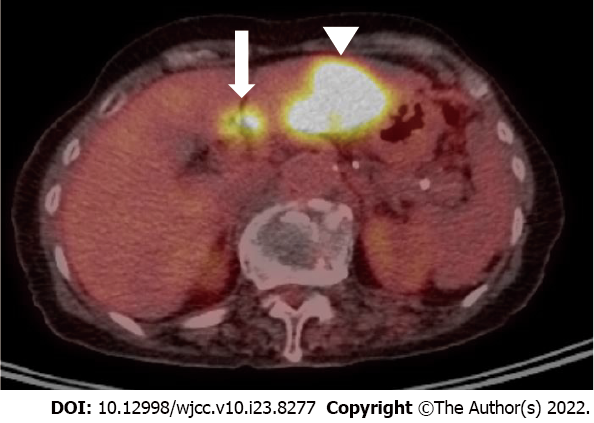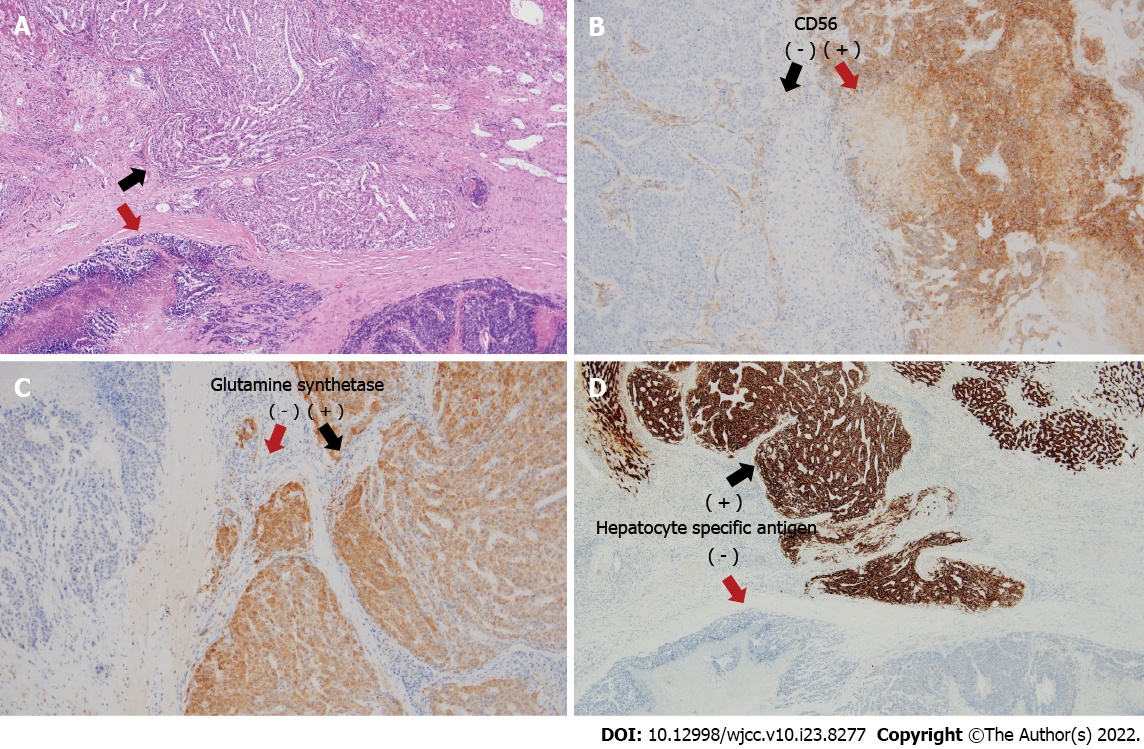Copyright
©The Author(s) 2022.
World J Clin Cases. Aug 16, 2022; 10(23): 8277-8283
Published online Aug 16, 2022. doi: 10.12998/wjcc.v10.i23.8277
Published online Aug 16, 2022. doi: 10.12998/wjcc.v10.i23.8277
Figure 1 Abdominal contrast-enhanced computed tomography (CT) examination of the collision tumor.
A: Before contrast; B: Arterial phase; C: Portal venous phase; D: Delayed phases. Computed tomography (CT) images demonstrate a 4.5-cm mass (arrowhead) in S3. This mass shows peripheral rim enhancement during the arterial phase and washout during the portal venous phase and delayed phase. This mass was categorized using liver imaging reporting and data system M observations. CT images also demonstrate a 1.3-cm metastatic lymph (arrow) node along the common hepatic artery.
Figure 2 Gadoxetic acid-enhanced liver magnetic resonance imaging.
A: T2-weighted image; B: Before contrast; C: Arterial phase; D: Portal venous phase; E: Transitional phase; F: Hepatobiliary phase. Magnetic resonance images (MRIs) demonstrate a 4.5-cm mass (arrowhead) in S3. This mass presents subtle high signal intensity to adjacent hepatic parenchyma, peripheral rim enhancement during the arterial phase, and washout during the portal venous phase, transitional phase, and hepatobiliary phase. This mass was categorized using liver imaging reporting and data system M observations. MRIs demonstrate a 1.3-cm metastatic lymph (arrow) node along the common hepatic artery.
Figure 3 18F-fluorodeoxyglucose positron emission tomography-computed tomography examination.
Positron emission tomography-computed tomography examination image demonstrates a 4.5-cm hypermetabolic mass (arrowhead) in S3 and a 1.3-cm metastatic lymph with avid FDG uptake (arrow) in the node along the common hepatic artery.
Figure 4 Histopathological analysis and immunohistochemical examination of the resected specimen.
The collision tumor comprises two distinct components: large-cell neuroendocrine carcinoma (red arrow) and hepatocellular carcinoma (black arrow). A: Hematoxylin-eosin staining (× 40); B and C: Immunohistochemical staining (B) for CD56 (× 100) and (C) glutamine synthetase staining (× 100); D: Hepatocyte-specific antigen staining (× 40).
- Citation: Noh BG, Seo HI, Park YM, Kim S, Hong SB, Lee SJ. Complete resection of large-cell neuroendocrine and hepatocellular carcinoma of the liver: A case report. World J Clin Cases 2022; 10(23): 8277-8283
- URL: https://www.wjgnet.com/2307-8960/full/v10/i23/8277.htm
- DOI: https://dx.doi.org/10.12998/wjcc.v10.i23.8277












